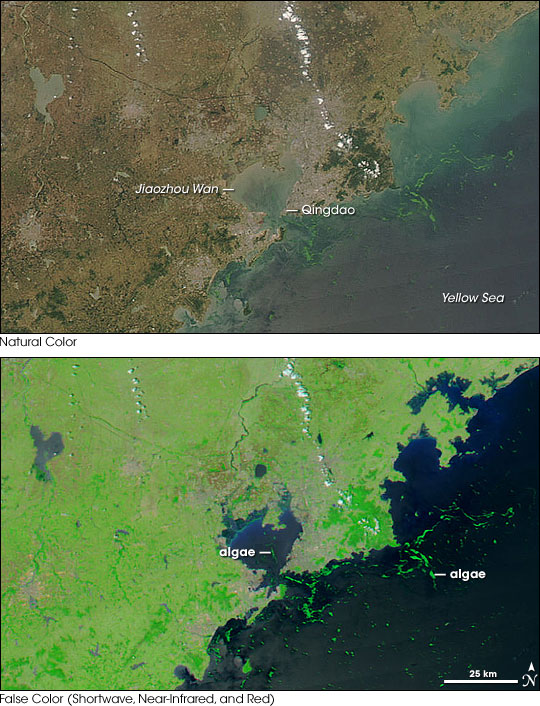


As Beijing prepared to host the 2008 Summer Olympics, the city of Qingdao, roughly 550 kilometers (340 miles) to the southeast, prepared its coastal waters for the games’ sailing competitions. With the games looming just weeks away, Chinese officials and residents of Qingdao (also known as Tsingtao) struggled with a stubborn adversary: algae.
On June 28, 2008, the Moderate Resolution Imaging Spectroradiometer (MODIS) on NASA’s Aqua satellite captured these images of Qingdao and the bay of Jiaozhou Wan. The top image is a natural-color image similar to what a digital camera would photograph. The bottom image is a false-color image made from a combination of light visible to human eyes and infrared light our eyes cannot see. In this image, vegetation appears vibrant green, including the strips of algae floating in the bay and in the nearby coastal waters.
These images show the bay at the beginning of a local cleanup effort. (Daily images of the area are available from the MODIS Rapid Response Team.) With sailing events scheduled to begin on August 9, Chinese officials ordered the algae cleanup to be completed by July 15. A spokesman for the Qingdao Sailing Committee planned to complete the project by July 10. The cleanup effort included 20,000 people and 1,000 boats.
According to news reports, opinions differed on the cause of the larger-than-normal algal bloom, with some people citing increased rainfall and unusually warm waters in the Yellow Sea. Others blamed wastewater, and industrial and agricultural pollution for providing excess nutrients on which the algae could thrive. Regardless of the cause, many locals agreed that the algae bloom was the worst they had seen.
NASA image courtesy the MODIS Rapid Response Team. Caption by Michon Scott and Rebecca Lindsey.